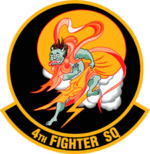| 4th Fighter Squadron | |
|---|---|
 Squadron F-35 Lightning II | |
| Active | 1941–1945; 1946–1969; 1971–1973; 1974–present |
| Country | |
| Branch | |
| Type | Squadron |
| Role | Fighter |
| Part of | Air Combat Command |
| Garrison/HQ | Hill Air Force Base, Utah |
| Nickname(s) | Fightin' Fuujins |
| Mascot(s) | Fuujin |
| Engagements |
|
| Decorations |
|
| Insignia | |
| 4th Fighter Squadron emblem (modified 1994)[1] |  |
| 4th Fighter Squadron emblem (approved 25 February 1949)[2] |  |
| 4th Fighter Squadron emblem (World War II)[3] |  |
The 4th Fighter Squadron, "Fighting Fuujins" is part of the 388th Fighter Wing at Hill Air Force Base, Utah. It operates the Lockheed Martin F-35 Lightning II aircraft, which replaced the unit's General Dynamics F-16 Fighting Falcons in August 2017. The 4th FS primarily conducts air superiority, strike, and close air support missions.
The squadron was first activated in 1941 as the United States Army Air Corps expanded prior to the entry of the U.S. into World War II. The squadron served in the Mediterranean Theater of Operations, where it earned two Distinguished Unit Citations. The squadron was reactivated in Okinawa as an all-weather fighter squadron in 1947. It served in the air defense of Japan until 1965 as the 4th Fighter-Interceptor Squadron, deploying to fly combat sorties during the Korean War.
The squadron returned to the United States in 1965, and reformed as the 4th Tactical Fighter Squadron. In 1969, it moved to Thailand, where it flew missions during the Vietnam War. After the war, the squadron moved to its current base at Hill. It again entered combat when it deployed as part of a provisional fighter wing during Operation Desert Storm. In 2019, the unit completed the first operational combat deployment of the F-35A, in support of Operation Inherent Resolve and Operation Freedom's Sentinel
- ^ a b c Haulman, Daniel (24 July 2015). "4 Fighter Squadron (ACC)". Air Force Historical Research Agency. Archived from the original on 4 March 2016. Retrieved 1 November 2016.
- ^ Maurer, Combat Squadrons, pp. 27–28
- ^ Watkins, pp. 24–25